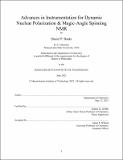Advances in Instrumentation for Dynamic Nuclear Polarization & Magic-Angle Spinning NMR
Author(s)
Banks, Daniel P.
DownloadThesis PDF (24.77Mb)
Advisor
Griffin, Robert G.
Terms of use
Metadata
Show full item recordAbstract
Dynamic nuclear polarization (DNP) is an invaluable tool for increasing the sensitivity of magic angle spinning (MAS) nuclear magnetic resonance (NMR) experiments. Historically, one of the primary drawbacks of DNP has been limited spectral resolution. The resolution of DNP spectra can be substantially improved via data acquisition at higher magnetic fields as well as faster MAS and increased experiment dimensions. However, achieving the maximum possible sensitivity and resolution in MAS DNP experiments is significantly limited by the equipment that is currently available. In this thesis I discuss new designs and fabrication methods for constructing instrumentation for DNP and MAS NMR with an emphasis on designing and fabricating equipment to enable ultra-fast MAS DNP experiments.
This thesis covers several topics including 3D printing stators for MAS experiments, the design of a balanced transmission line DNP probe for ¹⁷O experiments, the design of a helium recirculation system, and the fabrication of CVD diamond rotors for MAS DNP experiments. These projects are intended to increase the capabilities of MAS DNP equipment, leading to improved spectral sensitivity and resolution. The balanced transmission line probe design is compatible with a helium recirculation system and includes a new 1 mm stator design that should achieve MAS frequencies greater than 80 kHz at 100 K. At these spinning frequencies it will be possible to perform ¹H-detected DNP experiments that will not only provide access to an additional set of biological structural information, but also significantly improve the sensitivity of experiments over traditional ¹³C detection. The development of diamond MAS rotors is expected to increase the sensitivity and resolution of MAS DNP experiments even further via higher DNP enhancements and faster MAS.
Additional studies are presented on the amyloidogenic peptide GNNQQNY, which is used as a model system for ¹⁷O bound water studies and amyloid polymorphism. The aforementioned equipment will be used to perform ¹H-detected HON experiments on GNNQQNY to directly probe the hydrogen bonds present in the system. These studies will serve as a framework for future multidimensional ¹⁷O studies on complex biological systems.
Date issued
2021-06Department
Massachusetts Institute of Technology. Department of ChemistryPublisher
Massachusetts Institute of Technology